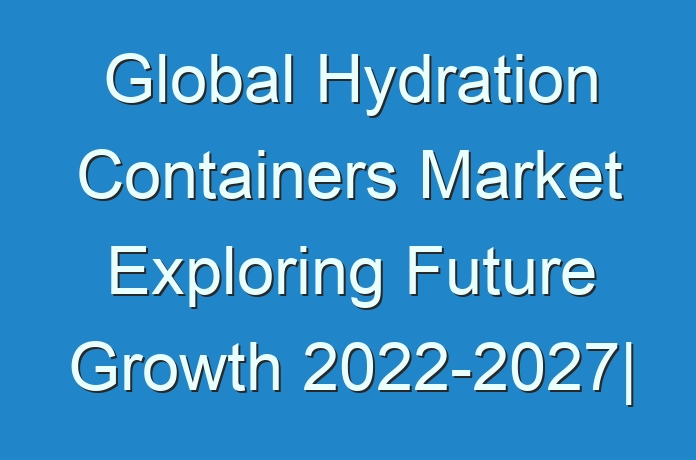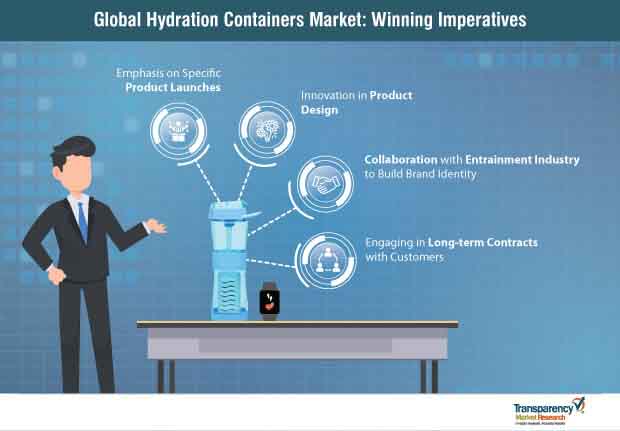
Environmental Concerns Trigger Demand for Hydration Containers
Plastic harms the environment more than most other material on the Earth. According to various reports, ~ 242 million tonnes of plastic waste was generated across the globe in 2016. Asia Pacific, Europe, and North America are the major contributors to plastic waste generation. To resolve this issue, various government and non-government organizations have started taking initiatives to reduce plastic waste generation. One such step is seen with the growth of hydration containers that comprise reusable water bottles, tumblers, shakers, infusers, etc., which has started gaining huge popularity among the masses. With nearly 100 million plastic bottles used every day, globally, which gives huge market potential for the growth of hydrations containers. Apart from environmental impact, changing preferences against the use of plastics bottles, increasing sports activities, and higher demand for lightweight consumer-friendly containers are also positively impacting the growth of this market.
To provide a complete understanding of the growth of the market, Transparency Market Research has recently published a report on the global hydration containers market. The report gives comprehensive information about the hydration containers market over the forecast period of 2019 and 2027.

Planning to lay down future strategy? Perfect your plan with our report brochure here https://www.transparencymarketresearch.com/sample/sample.php?flag=B&rep_id=37952
Hydration Containers Help in Reducing Carbon Footprint
The first synthetic plastic — Bakelite — was manufactured in 1907, and marked the beginning of the global plastics industry. Since then, this industry has evolved significantly and has undergone various transformations. Gradually, the usage of synthetic plastic has increased for making water bottles and other beverage containers/bottles. Eventually, the quantity of production and the use of plastic bottles increased tremendously, adversely affecting the environment.
However, to reduce the environmental effects of plastic bottles, the demand for reusable bottles has increased significantly across the globe. Reusable bottles can used around 80 times, thus, helps in reducing the carbon footprint of plastic. Moreover, increasing pressure on landfilling and recycling issues due to single-use bottles has further fueled the demand for reusable bottles that are made of polymer, metal, glass, and silicon. Manufacturers are also innovating in terms of product design and features such as vacuum insulation, embedded mist sprayers, and infusers. These latest innovations are expected to increase the overall revenue generated by the hydration containers market in 2019 to ~ US$ 9.7 Bn, and to US$ 15.6 Bn by the end of 2027.
Hydration Containers Market Trends
Innovation in Product Design – A Lucrative Opportunity for Market Players
Players manufacturing hydration containers are focusing on innovating and developing new and advanced products by introducing new designs. Innovative products have lately been introduced in the hydration containers market across the globe, including filters, infusers, and mist sprayers. This conventional shift in the production of hydration containers is mainly being seen due to the increasing emphasis on health and healthy living. All these innovations in hydration containers have helped market players generate huge revenue, as a large number of customers are willing to buy these innovative products. Customers who are health conscious are more inclined towards using infuser embedded hydration containers that help in mixing herbs and fruits with water without any hassle. The demand for mist sprayers in bottles and filters has also gained huge attention from customers across the globe. Pertaining to these trends, various hydration container manufacturers are now investing in research and development to introduce these features in bottles at a lower cost. One such example is of Contigo; the company recently launched Cortland infusers in 2017. These bottles are equipped with Autoseal technology, which ensures a pleasant and spill-free drinking experience with fresh added herbs and fruits.
Advent of Smart Bottles to Expand Market Scope
Nowadays, people are more inclined towards convenience products, which has led to the development of smart bottles that are gradually making their presence felt in the global market. Moreover, people are now more aware of information technology in healthcare, which explains the growing importance of smart bottles across the world.
The growing prominence of wireless technology and increasing use of connected devices such as smartphones, smartwatches, tablets, and others has encouraged manufacturers to develop smart water bottles. These bottles are easily connected via Bluetooth, and send notifications to a user’s connected smartphone through an application. Some types of smart water bottles glow to indicate to the user that it is time to drink water. Another addition is time-temperature indicators that help in tracking the temperature of the water stored in the bottle. These bottles are widely popular among millennials and tech-savvy individuals. An example of this growing trend is the increasing sales of a company called Hidrate, which has neared to US$ 1 million revenue mark due to the popularity of its Hidrate Spark bottles among consumers. Hidrate Spark is a connected water bottle that tracks water intake and synchronizes to the Hidrate Spark app, which recommends a daily customized goal.
Want to know the obstructions to your company’s growth in future? Request a PDF sample here https://www.transparencymarketresearch.com/sample/sample.php?flag=S&rep_id=37952
Winning Strategies for Market Players
Institutional Customers – Lucrative Customer Base for Players
One of the biggest strategies that can be used by hydration container manufacturers and players is to aim for customers who are tech-savvy, and are already aware of smart bottles and innovative hydration containers. While adopting this strategy, players can target institutional customers, as they are mostly aware of these new developments. Recently, there has been a remarkable rise in the use of hydration containers by many corporate enterprises and fitness companies. These companies are restricting the use of single-use bottled water on their premises. This creates an opportunity to fulfill the growing demand from these institutions, which needs to be fulfilled by reusable water bottle/hydration container manufacturers.
Leveraging Promotion Activities to Thrive Sales
Players in the global hydration containers market are adopting innovative promoting strategies to increase their sales and attract a larger customer base. To increase their brand presence, players are promoting their products on various online platforms, and imprinting their logos or messages on their products, and distributing them to their target markets to attract more customers. Customizing hydration containers is another strategy widely being used by various players. They are now customizing hydration containers for special occasions and festivals such as New Year and Christmas, which gives them an upper hand and increases their presence among customers. Another key strategy used by hydration container players is collaborations with entertainment companies. For example, in 2017, Nalgene Outdoor launched 32-ounce wide mouth new Marvel Universe-inspired bottles for its customers, to open up more choices for customers using its reusable bottles.
Despite the persistent efforts made by market players, the high manufacturing cost associated with metal and glass hydration containers restricts market growth. Due to the high cost of production, few manufacturers use low-quality glass and metal to reduce the price of the end product, which hampers quality. However, various companies are focusing on research and development activities to reduce the cost of production of hydration containers.
Technological Advancements to Intensify Market Competition
The global hydration containers market is highly fragmented, as a large number of local and regional players hold ~ 90% share in the global market. These players have revenues between US$ 20 Mn to US$ 50 Mn, annually, in the global hydration containers market. Leading manufacturers such as Tupperware Brands Corporation, Zhejiang Haers Vacuum Containers Co., Ltd., S’Well Corporation, and Camelbak Products, LLC hold ~ 6% share in the global market.
A large number of players are focusing on product expansion. Increasing deployment of advanced technologies and rising focus of players in re-engineering their existing products have resulted in the introduction of new products. The hydration containers market is also expected to witness high competition due to increasing use of advanced technologies by various players to introduce different products in the market. The increasing number of sports enthusiasts and higher preference for healthy drinks and juices have also compelled hydration containers manufacturers to innovate in their products. For example, in August 2016, CamelBak Products, LLC launched the industry’s first insulated collapsible water bottle – Quick Stow Chill Flask – and a non-insulated version – Quick Stow Flask. This was done focusing on sportspersons and athletes.





